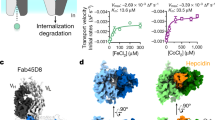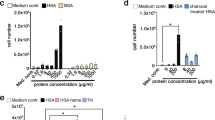Abstract
His349 in human transferrin (hTF) is a residue critical to transferrin receptor (TFR)-stimulated iron release from the C-lobe. To evaluate the importance of His349 on the TFR interaction, it was replaced by alanine, aspartate, lysine, leucine, tryptophan, and tyrosine in a monoferric C-lobe hTF construct (FeChTF). Using a stopped-flow spectrofluorimeter, we determined rate processes assigned to iron release and conformational events (in the presence and in the absence of the TFR). Significantly, all mutant/TFR complexes feature dampened iron release rates. The critical contribution of His349 is most convincingly revealed by analysis of the kinetics as a function of pH (5.6–6.2). The FeChTF/TFR complex titrates with a pK a of approximately 5.9. By contrast, the H349A mutant/TFR complex releases iron at higher pH with a profile that is almost the inverse of that of the control complex. At the putative endosomal pH of 5.6 (in the presence of salt and chelator), iron is released from the H349W mutant/TFR and H349Y mutant/TFR complexes with a single rate constant similar to the iron release rate constant for the control; this suggests that these substitutions bypass the required pH-induced conformational change allowing the C-lobe to directly interact with the TFR to release iron. The H349K mutant proves that although the positive charge is crucial to complete iron release, the geometry at this position is also critical. The H349D mutant shows that a negative charge precludes complete iron release at pH 5.6 both in the presence and in the absence of the TFR. Thus, histidine uniquely drives the pH-induced conformational change in the C-lobe required for TFR interaction, which in turn promotes iron release.




Similar content being viewed by others
Abbreviations
- BHK cells:
-
Baby hamster kidney cells
- Fe2hTF:
-
Diferric human serum transferrin
- FeChTF:
-
Recombinant N-terminal hexa-His-tagged nonglycosylated monoferric human serum transferrin that binds iron only in the C-lobe
- hTF:
-
Human serum transferrin
- MES:
-
2-Morpholinoethanesulfonic acid
- NTA:
-
Nitrilotriacetic acid
- oTF:
-
Ovotransferrin
- sTFR:
-
Glycosylated, N-terminal hexa-His-tagged soluble recombinant transferrin receptor (residues 121–760)
- TBE:
-
Tris(hydroxymethyl)aminomethane–borate–EDTA
- TF:
-
Serum transferrin
- TFR:
-
Transferrin receptor
- Tris:
-
Tris(hydroxymethyl)aminomethane
References
Klausner RD, Ashwell G, van Renswoude J, Harford JB, Bridges KR (1983) Proc Natl Acad Sci USA 80:2263–2266
Dautry-Varsat A, Ciechanover A, Lodish HF (1983) Proc Natl Acad Sci USA 80:2258–2262
Aisen P, Enns C, Wessling-Resnick M (2001) Int J Biochem Cell Biol 33:940–959
Zak O, Aisen P (2003) Biochemistry 42:12330–12334
Giannetti AM, Halbrooks PJ, Mason AB, Vogt TM, Enns CA, Bjorkman PJ (2005) Structure 13:1613–1623
Byrne SL, Chasteen ND, Steere AN, Mason AB (2010) J Mol Biol 396:130–140
Aisen P, Leibman A (1968) Biochem Biophys Res Commun 30:407–413
Lawrence CM, Ray S, Babyonyshev M, Galluser R, Borhani DW, Harrison SC (1999) Science 286:779–782
Giannetti AM, Snow PM, Zak O, Bjorkman PJ (2003) PLoS Biol 1:E51
Cheng Y, Zak O, Aisen P, Harrison SC, Walz T (2004) Cell 116:565–576
Mason AB, He QY, Halbrooks PJ, Everse SJ, Gumerov DR, Kaltashov IA, Smith VC, Hewitt J, MacGillivray RT (2002) Biochemistry 41:9448–9454
Byrne SL, Leverence R, Klein JS, Giannetti AM, Smith VC, MacGillivray RT, Kaltashov IA, Mason AB (2006) Biochemistry 45:6663–6673
James NG, Mason AB (2008) Anal Biochem 378:202–205
Pace CF, Vajdos F, Fee L, Grimsley G, Gray T (1995) Protein Sci 2411–2423
Wetlaufer DB (1962) Adv Protein Chem 17:303–391
Lehrer SS (1969) J Biol Chem 244:3613–3617
James NG, Berger CL, Byrne SL, Smith VC, MacGillivray RT, Mason AB (2007) Biochemistry 46:10603–10611
Byrne SL, Mason AB (2009) J Biol Inorg Chem 14:771–781
James NG, Byrne SL, Mason AB (2008) Biochim Biophys Acta 1794:532–540
Dougherty DA, Stauffer DA (1990) Science 250:1558–1560
Ma JC, Dougherty DA (1997) Chem Rev 97:1303–1324
Zacharias N, Dougherty DA (2002) Trends Pharmacol Sci 23:281–287
Williams S, Bledsoe RK, Collins JL, Boggs S, Lambert MH, Miller AB, Moore J, McKee DD, Moore L, Nichols J, Parks D, Watson M, Wisely B, Willson TM (2003) J Biol Chem 278:27138–27143
Yamamoto T, Chen HC, Guigard E, Kay CM, Ryan RO (2008) Biochemistry 47:11647–11652
Gerchman Y, Olami Y, Rimon A, Taglicht D, Schuldiner S, Padan E (1993) Proc Natl Acad Sci USA 90:1212–1216
Rotzschke O, Lau JM, Hofstatter M, Falk K, Strominger JL (2002) Proc Natl Acad Sci USA 99:16946–16950
Feliciangeli SF, Thomas L, Scott GK, Subbian E, Hung CH, Molloy SS, Jean F, Shinde U, Thomas G (2006) J Biol Chem 281:16108–16116
Sakajiri T, Yamamura T, Kikuchi T, Yajima H (2009) Protein J 28:407–414
Penhallow RC, Brown-Mason A, Woodworth RC (1986) J Cell Physiol 128:251–260
Acknowledgments
This work was supported by the United States Public Health Services (R01 DK21739) for A.B.M.and the National Institute of General Medical Sciences (R01 GM20194) for N.D.C. Support for A.N.S. and S.L.B. came from the Hemostasis and Thrombosis Training Grant (5T32HL007594), awarded to K.G. Mann at The University of Vermont by the National Heart, Lung and Blood Institute.
Author information
Authors and Affiliations
Corresponding author
Electronic supplementary material
Below is the link to the electronic supplementary material.
Rights and permissions
About this article
Cite this article
Steere, A.N., Byrne, S.L., Chasteen, N.D. et al. Evidence that His349 acts as a pH-inducible switch to accelerate receptor-mediated iron release from the C-lobe of human transferrin. J Biol Inorg Chem 15, 1341–1352 (2010). https://doi.org/10.1007/s00775-010-0694-2
Received:
Accepted:
Published:
Issue Date:
DOI: https://doi.org/10.1007/s00775-010-0694-2




